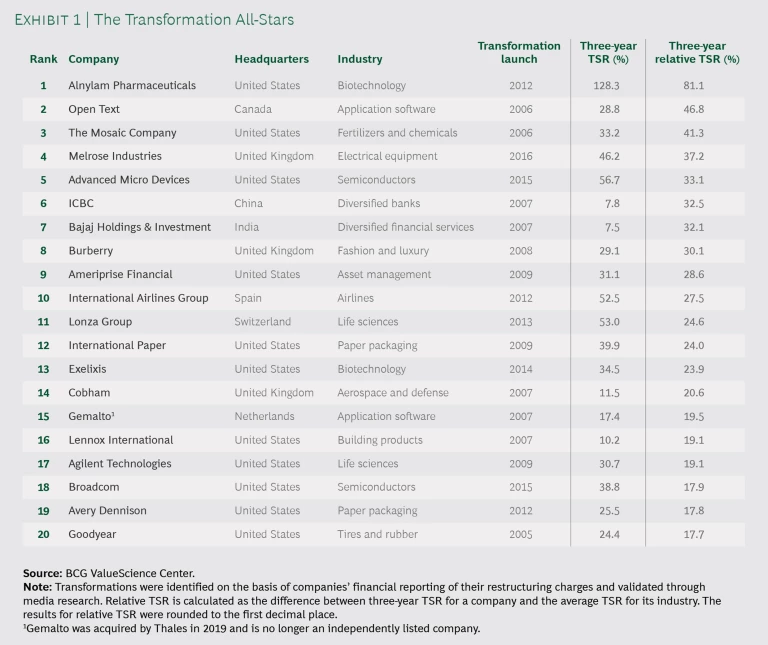The COVID-19 pandemic has dramatically raised the stakes for corporate transformations. Many companies will need to launch a transformation to remain competitive, yet the risks associated with failure are now higher. Unfortunately, transformation outcomes vary widely; some organizations waste significant time and money and lose leadership credibility pursuing measures that don’t meaningfully secure the company’s performance, particularly in uncertain times. Our research shows that companies must accomplish three goals to create superior value from a crisis transformation: deliver near-term improvements to profit margins, strengthen the core operating and business models, and rigorously manage the change.
Those insights are the result of analyzing 174 large-scale change programs over the past 15 years to identify those that resulted in the best company performance three years after the transformation was launched. Notably, our sample included companies that took the bold step of beginning a transformation in the middle of the global financial crisis (2008) or at the height of Grexit in Europe (2012). Within each industry, the companies that launched a transformation collectively outperformed the industry average in total shareholder return (TSR), but the performance of the companies that implemented a transformation varied widely. Top-quartile companies beat their industry’s average by more than 7.5 percentage points a year (nearly 25 percentage points of TSR over three years). Laggards in the bottom quartile, conversely, trailed their industry’s average by 5 percentage points or more.
A quantitative analysis of the top performers (our Transformation All-Stars) shows important patterns related to how these companies focused their efforts during their transformation. Specifically, the top performers made changes that dramatically improved their profit margins and valuation multiples. In the meantime, a qualitative analysis identified seven consistent themes in these organizations’ approaches to change management. We believe these findings highlight the moves that companies need to make to implement a successful transformation—moves that are more critical now in the wake of COVID-19.
The Importance of Margins and Multiples
Exhibit 1 shows the full list of Transformation All-Stars, which we ranked by relative TSR (rTSR). That metric shows how a company performed relative to its industry’s average. Breaking the group down by quartile shows the importance of individual contributors to value creation . As Exhibit 2 shows, sales growth and dividend yields (cash paid out to investors) were relatively similar across performance quartiles. However, changes in margins and valuation multiples varied significantly. Improvements in each had a much bigger impact on companies’ performance.
Margin improvement is measured as the average growth rate of the EBITDA margin over the three-year period. A contribution of 5 percentage points, as accomplished by companies in the top quartile, is quite meaningful—a company that started the transformation with an EBITDA margin of 10% would improve a little more than 50 basis points a year for three straight years. By contrast, the bottom quartile’s contribution of –3 percentage points highlights the importance of delivering immediate improvements to profit margins during the transformation.
Improvement in the valuation multiple has a similar impact on transformation success. This is noteworthy because empirical analysis typically shows margins and multiples moving in opposite directions. Investors buy shares in a company undergoing a transformation, but multiples decline as those investors predict that it will revert to historical levels of performance. Our group of Transformation All-Stars delivered big gains on both fronts. This implies not only that margins are improving for these companies but also that investors are expecting performance to improve even more in subsequent years by virtue of the changes to the business and how they are announced publicly.
That is a critical finding—successful transformers aren’t simply cutting costs for a one-time, quick-hit boost in financial performance. They are setting up the company to win over a more sustained period.
Managing Successful Change
But not all change can be measured in terms of financial performance and stock price movement. That’s where the third and most critical aspect comes in: transformations require rigorous execution and change management.
We conducted in-depth research on some of the top-performing companies in our sample and spoke with leadership teams that implemented successful transformations. (See “Avery Dennison Transforms a Key Business Unit.”) Through that research, we identified seven key themes for executing large-scale change and striking the right balance between short-term and longer-term initiatives.
AVERY DENNISON TRANSFORMS A KEY BUSINESS UNIT
AVERY DENNISON TRANSFORMS A KEY BUSINESS UNIT
Avery Dennison is an $8 billion manufacturer that specializes in applying materials science to labeling and packaging. In 2011, the company found itself struggling with persistent headwinds and a stock price that had fallen to about $25 per share from a high near $70 per share prior to the global financial crisis. CEO Dean Scarborough and CFO Mitch Butier launched a broad transformation to strengthen the company’s position. There were four key strategies: drive outsized growth in high-value segments, grow profitably in the main business, relentlessly focus on productivity, and deploy capital effectively.
Investors responded positively to those changes, and in 2015, with Butier now in the role of president and COO, Avery Dennison launched its most ambitious initiative to date, a full transformation of the company’s Retail Branding and Information Solutions (RBIS) unit. RBIS is the largest global manufacturer of apparel tags and labels used to communicate brand or other information (such as care instructions or prices) to consumers. Deon Stander had just been promoted to vice president and general manager to lead it.
In an industry where customer service and responsiveness are everything, RBIS was losing ground. Asian competitors had emerged with simpler business models and lower costs. Changes in buying patterns were an issue as well—factory partners began playing larger roles alongside brand owners (with which RBIS traditionally had its strongest relationships) in purchasing decisions. In all, RBIS still led the market, but it was losing share and generating returns below the cost of capital.
Faced with this situation, RBIS launched a turnaround with a clear vision and message: make the business faster, simpler, and more competitive. As one of its many initiatives, RBIS streamlined the organization by removing management layers and redundant resources. It closed or converted 15% of its manufacturing capacity, and it redesigned its sales structure to better meet evolving customer needs. And in a sign of how seriously the unit’s leaders took the initiative, they shut down the division’s headquarters in Boston and moved it to Hong Kong to be closer to the customer base.
“Creating a clear vision was critical to ensuring the engagement of all 20,000 employees,” Stander said. “Our vision was for RBIS to deliver superior returns because it delighted its customers with more flexibility, better service, and higher value solutions. Having a simple communication mechanism around the idea of becoming more competitive, faster, and simpler allowed for a complex program of transformation activity to be easily linked, understood, and acted on by the teams. And fundamentally changing the culture—from one of centralized control to one of distributed empowerment of the teams closest to the markets and customers—enabled the ownership, accountability, and, ultimately, the success of the transformation.”
The efforts paid off. In all, the program generated more than $150 million in annual cost savings. Decision rights were simplified, and decisions were accelerated. Processes, such as order and delivery, were streamlined, making the company far more responsive. By mid-2018, the unit was growing several hundred basis points per year faster than the average for its industry and delivering operating margins in excess of 10%, nearly doubling its profitability from before the transformation. Overall RBIS’s turnaround helped Avery Dennison deliver a three-year relative TSR of 17.8% in our analysis and achieve a rank of 19th on our list of Transformation All-Stars.
These themes all point to the importance of managing change with a programmatic approach, with strong and consistent communication about quantitative goals and priorities, and with empathy. This is somewhat counterintuitive—senior leaders in many organizations believe in creating accountability by setting targets and giving their reports wide latitude to devise initiatives to achieve the goals. But in our experience, this approach can backfire, and the senior team may hit their targets in ways that are ultimately unsustainable or counterproductive. A better path is illustrated by the following seven themes.
Set a clear vision, and keep the communication simple and straightforward. Getting all employees to have the same understanding of the vision and objectives for the transformation is crucial, and companies can accomplish this through clear and vivid communication. Transformation All-Stars create an internal brand or title for the program, and they use very simple, consistent messaging to reinforce the key themes and objectives.
It is crucial for all employees to have the same understanding of the transformation’s vision and objectives.
Analytically derive ambitious targets. Transformation All-Stars rapidly diagnose their business performance and continually evaluate external benchmarks to set stretch targets early on—particularly for cost savings—so that their company can fund the necessary investments in growth. And top performers use KPIs to measure and communicate improvement. A financial services company in our sample announced that it wanted to achieve a double-digit return on equity by significantly reducing costs, which it would accomplish by simplifying the organization, closing branch locations, and streamlining IT (including digitizing some processes).
Launch a formal, structured program. Because a large-scale transformation is complex and has multiple interdependencies, it can succeed only if it is structured as a formal program with well-defined work streams and initiatives. This approach allows companies to track their progress throughout the change effort and determine which aspects may require additional attention. Transformation All-Stars create a transformation office with dedicated teams that design the structured program and deliver the change effort; these teams have direct reporting lines to the CEO and explicit support from the board of directors and the CEO.
Ensure that the executive team is fully committed to success. Visible support for the change—from all members of the leadership team, including the CEO—is absolutely critical. In some cases, leadership changes may be required to shake up a slow-moving culture. At one company in our study, the CEO held a town hall meeting for all employees the night before the transformation was announced publicly. He had a simple message—if the organization didn’t transform through significant cost cuts and some reduction in head count, it would fail. The CEO deliberately chose to deliver this message in person and take employee questions to show his support and commitment to the program. Ultimately, about one-third of the senior team was replaced by external people because the board believed that new talent was necessary to change the culture.
Engage employees throughout the process. Frontline employees can make or break a transformation, so it’s crucial to frequently check the pulse of the organization. A beverage manufacturer that successfully completed its transformation organized a series of workshops to make sure that all employees understood the company’s vision and the changes ahead; the workshops were conducted for the executive team first and then for lower-level employees. The transition team structured the workshops to answer critical questions. For example: What does the transformation mean to you? What will change for you? What will it take to succeed? How can you play a contributing role in this success?
Frontline employees can make or break a transformation, so check the pulse of the organization frequently.
Strike a balance between pragmatism and empathy. The leader of any transformation effort needs to be resilient and determined to deliver the program’s full potential. Yet that person also needs to understand and acknowledge the needs of employees during a radical upheaval. Sometimes leaders must be pragmatic—particularly when the company’s long-term survival is at stake. At other times, empathy and flexibility are more effective.
One CEO brought determination and conviction to the company’s transformation, and he was able to tamp down dissent, gossip, and negative press. He was also willing to reverse his decisions on some matters. For example, one cost-reduction measure was a cutback in employee travel. Initially, the CEO told employees that they needed direct approval from him for any travel expenses above a certain amount. However, after about a year, he relaxed this policy after considering employees’ feedback.
Manage investors’ expectations through calculated, regular communications. Companies need to carefully manage investor communications to strengthen—or even regain—credibility with the capital markets. Management needs to send a credible and compelling message that articulates the case for change, the over-arching ambition, and sufficient detail about the most important initiatives. Of course, the transformation must deliver early results to earn the trust of the market. In addition, management must communicate its plans for later stages and the milestones that investors should be looking for. All of this is only possible if the company has developed a deep understanding of the expected sequence of events and laid out a roadmap.
Transformations are a proving ground for leadership teams. They can be catalysts to long-term business success and financial performance—but companies undergoing a transformation underperform almost as often as they outperform. Our analysis shows that there is a systematic way to increase the odds of success. By focusing on profit margins, strengthening the operating and business models, and rigorously managing the change, companies can truly transform and put themselves on
a path for dramatically stronger value creation
.
BCG TURN
is a special unit of BCG that helps CEOs and business leaders deliver rapid, visible, and sustainable step-change improvement in business performance while strengthening their organizations and positioning them to win in the years ahead. BCG TURN helps organizations change their trajectories by turning their upside potential into radical performance gains. The BCG TURN team consists of transformation practitioners and battle-tested experts with a proven track record in large-scale transformation. BCG TURN is invested in the sustainable success of clients, with a focus on performance acceleration and a commitment to value delivered.













